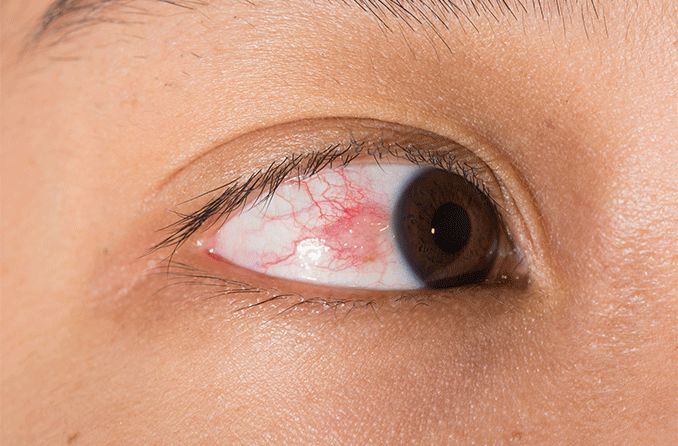What is episcleritis?

Episcleritis is a mild eye condition that causes inflammation and redness of the episclera, the thin layer of tissue between the conjunctiva and the layer of tissue which makes up the white of the eye (sclera).
The condition often occurs in one portion of the white of the eye, but in some cases, it can affect the entire eye. Similarly, while episcleritis tends to occur in only one eye, it can sometimes affect both. Less commonly, a small bump may also develop.
Episcleritis can typically be identified by redness in the eye that is painless and does not occur along with discharge.
While many cases heal on their own or require minimal treatment, it is still important to see an eye doctor for a proper diagnosis and treatment plan.
Types of episcleritis
There are two main types of episcleritis: simple and nodular. Simple episcleritis is more common and is usually characterized by redness and irritation, while nodular episcleritis presents with a bump (or bumps) on the outside of the eye.
Simple episcleritis
Simple episcleritis can occur in two subtypes: diffuse or sectoral. Both subtypes of simple episcleritis typically cause redness and some irritation but do not often include soreness or pain.
Diffuse episcleritis: redness occurs throughout the eye
Sectoral episcleritis: redness occurs in one part of the eye
Simple episcleritis usually lasts between 7 and 10 days, but it can be more severe and/or more prolonged for some people.
Nodular episcleritis
Nodular episcleritis is diagnosed when a nodule or small bump forms on the outside of the eye. Unlike most cases of simple episcleritis, which mainly cause redness and some irritation, nodular episcleritis may involve some discomfort.
Nodular episcleritis is more likely to occur because of an underlying medical condition, including Crohn’s disease and rosacea, and may last longer than the 7- to 10-day period that simple episcleritis typically lasts.
Causes of episcleritis
There is no known direct cause of episcleritis, but the condition may be more likely to occur in people with underlying systemic inflammatory conditions that affect the body as a whole, such as:
Rosacea
Crohn’s disease
Gout
Inflammatory bowel disease
Chances of developing episcleritis may also be higher for those who take certain medications as well, including pamidronate and topiramate.
Pamidronate: used to treat high levels of calcium in the blood
Topiramate: used to treat and prevent seizures
Episcleritis can also be triggered by an eye injury. As a general note, if you experience an eye injury that affects your vision, causes bleeding in the eye or any other major concerns, contact an eye doctor immediately.
Symptoms of episcleritis
Redness is the most prominent symptom of both types of episcleritis, but there are several indicators that may point to an occurrence of the condition.
Episcleritis symptoms may include:
Redness in either one specific area or throughout the eye
Irritation
Burning
Discomfort (in cases of nodular episcleritis)
Formation of a small bump/nodule on the eye (in cases of nodular episcleritis)
Episcleritis may occur in one or both eyes and is frequently a recurring condition for those who experience it. Although the condition can cause overall irritation for the eye, it does not affect visual acuity.
The appearance and some symptoms of episcleritis, for instance, redness or light sensitivity, can be mistaken for pink eye, with one key difference — episcleritis does not usually have discharge. See an eye doctor if you experience symptoms of either in order to receive proper treatment.
SEE RELATED: Pink eye (conjunctivitis): Symptoms, causes and treatment
Diagnosis
Episcleritis is diagnosed through an examination performed by an ophthalmologist. During the exam, your ophthalmologist may use special eye drops to help confirm where symptoms are occurring in the eye. A slit lamp may be used to shine light into the eye as well.
Treatment for episcleritis
Most cases of episcleritis go away on their own within 7 and 10 days. For more severe cases, an eye doctor may prescribe oral anti-inflammatory medication, a topical anti-inflammatory ointment or eye drops.
A cold compress may be used at home to provide relief from episcleritis symptoms. An over-the-counter anti-inflammatory medication such as ibuprofen (Advil) may also be taken to treat the condition at home.
If you experience worsening episcleritis, or if the condition persists for longer than 10 days after it is diagnosed, consult an eye doctor for additional evaluation and treatment.
Episcleritis vs. scleritis
Though similar in name (and some symptoms), episcleritis is a separate condition from scleritis. Episcleritis is considered a mild condition, while scleritis can be severe enough to be threatening to vision.
Episcleritis causes inflammation of the episclera, a thin outer layer of tissue. Scleritis is a more serious condition that causes inflammation of the sclera, which can cause bigger complications for the eye.
Episcleritis is often not painful and may heal on its own within 7 to 10 days, whereas scleritis requires treatment and may last for weeks. Both conditions can be recurring for people who have underlying inflammatory conditions.
Some similarities of episcleritis and scleritis include:
Acute onset of condition
Inflammation
Redness
May be associated with an underlying systemic medical condition
May be a recurring condition for those with an underlying medical condition
Episcleritis does not typically lead to scleritis. It is possible, however, that a case of episcleritis can develop due to an onset of scleritis.
Consistent episcleritis may indicate other health problems
Episcleritis is generally a mild eye condition, but if it occurs consistently, it could be a sign of another underlying health condition and should be taken seriously. Bloodwork may be required to detect an underlying condition which may be affecting the health of your eyes.
To keep your eyes in the best possible health, it is important to have a comprehensive eye exam once a year. In addition to general vision changes, an eye exam can help detect other health problems, whether they directly affect the eyes or another part of the body.
Page published on Wednesday, January 27, 2021






